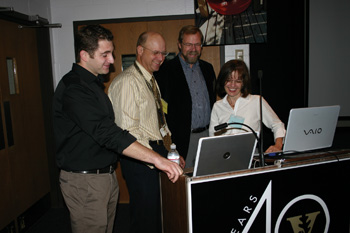
From left, Daniel Polley, Stephen Camarata, Christoph Schreiner and Beverly Wright at the Kennedy Center’s recent conference.
Photo by Melanie May
Kennedy Center conference shines light on auditory research advances
It's not often that researchers who map the brain's auditory system have an opportunity to sit in the same room and talk for two days with researchers who do clinical work using auditory interventions designed to improve listening comprehension in people with disabilities.
What is known about the auditory system — and how much is yet to still be learned — was the subject of a recent Vanderbilt Kennedy Center two-day conference that brought together Vanderbilt's cadre of auditory system and language intervention experts with several of the nation's leading researchers in the field.
The conference “Integrating Auditory Perception, Processing and Comprehension: New Directions for Research,” was organized by Stephen Camarata, Ph.D., director of the Kennedy Center’s Research Program on Communication and Learning. Also instrumental in planning the conference were Mark Wallace, Daniel Polley and Troy Hackett.
The conference was an outgrowth of the the Kennedy Center’s commitment, laid out in its strategic plan, to build research strength in auditory system development, plasticity and function, and to become a national and international leader in auditory research.
“Great strides have been made in understanding the visual and somatosensory systems,” said Pat Levitt, Ph.D., Kennedy Center director, in opening the conference, “but the auditory system is a modality that has been underrepresented.”
Each of the dozen researchers who presented is preparing papers that will be published and will contribute to setting a future national research agenda, Camarata indicated.
“Our goal was to span the breadth of the field,” Camarata continued, “both basic and applied clinical research — from basic processes, with maps of the auditory cortex, animal and human imaging, and genetics, through applied clinical interventions. Putting it all together is so very important.”
Among the highlights:
• Troy Hackett kicked off the conference with a presentation on the anatomy of the auditory cortex, based on research with primates. He emphasized that the long-term goal is to understand the structure and function of human auditory cortex organization. “We are a long way from achieving this,” Hackett acknowledged.
• Daniel Polley summarized neurophysiological correlates of perceptual learning in the auditory cortex. The long-term goal of his research program is to develop therapies for auditory processing disorders that are based on state-of-the-science understanding of the auditory system and brain plasticity.
• Beverly Wright presented on human discrimination learning on basic auditory tasks. Wright, associate professor of communication sciences and disorders at Northwestern University, emphasized theoretical implications.
“Our sensory systems are not rigid, but change with experience, and by studying how people learn, we can infer basic processes,” Wright said.
• Vanderbilt's Mark Wallace focused on multisensory processes — the interactions among hearing, vision, and touch. He summarized that multisensory neurons and multisensory integration develop over a protracted period of post-natal life in both cortical and subcortical circuits.
• Auditory processing in the context of broad cognitive abilities was reviewed by Richard Woodcock, Vanderbilt visiting professor of Hearing and Speech Sciences. He provided evidence that auditory processing ability is, in fact, a key correlate of overall intellectual ability.













